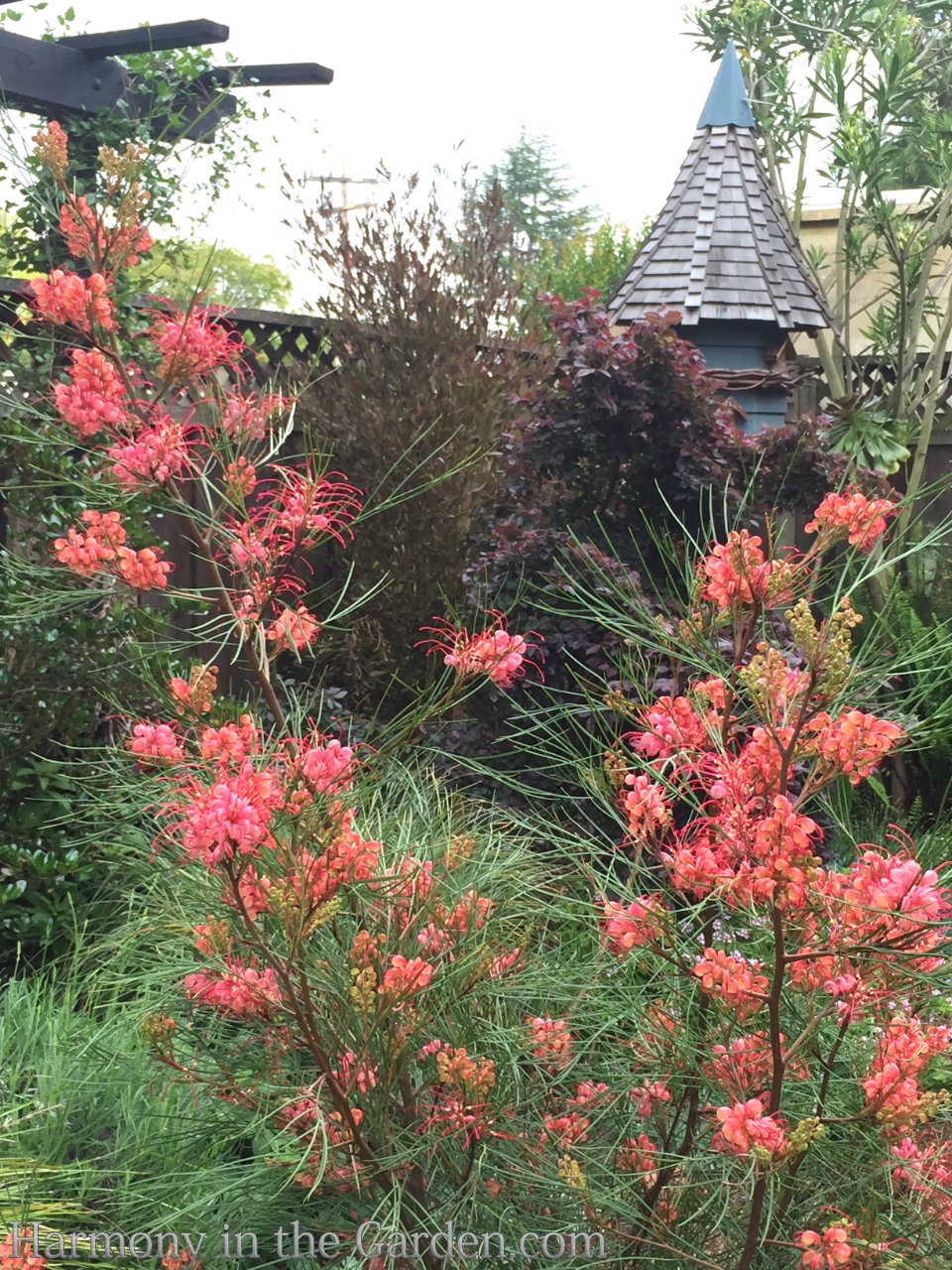
Why do I love grevilleas for drought-tolerant, deer-resistant gardens? Let me count the ways:
1. They take 100-degree days in the full sun like a champ, never showing a hint of fatigue (which makes sense since they’re native to Australia!)
2. They’re also deer-resistant, thanks to irritating substances in the foliage and flowers. I’ve watched entire families of deer walk through my grevilleas, not even bothering to try a nibble.
3. Grevilleas look just as good in the winter as they do in the summer (in my zone-9 climate.) A few varieties, in fact, bloom heaviest in February and March, when little else is blooming.
4. Grevilleas bloom intermittently throughout the year – no ‘one hit wonders’ with this group! To the delight of hummingbirds and pollinators, these shrubs are covered with blooms.

5. Their flowers come in a HUGE range of colors, shapes, and sizes. From 6-inch, spidery-shaped flowers to 4-inch toothbrush-shaped flowers, all the way down to 1-inch curlicue blooms.
Flower colors range from hot reds, oranges, and pinks to pastel shades of creamy white, soft peach and yellow.
6. Grevilleas come in a HUGE range of sizes, from towering 15’+ varieties to mid-size 4’ beauties, all the way down to 2’ groundcovers.
This makes grevilleas ideal for evergreen privacy screens, year-round ‘bones’ of a garden bed, or winter-blooming groundcovers.

Now, for my cold-climate readers, a few varieties do well down to zone 7 (some survive down to 0-10 degrees), but for the most part, grevilleas do best in warmer climates. I’ll provide links to grevilleas that can withstand colder temps at the end of this post.
However, it’s important to note that it’s not necessarily the colder temps that kill them; it’s the lack of fast-draining soil, which does them in.
Grevilleas hate soggy roots and standing water.
As mentioned, grevilleas require very little water once established. In the hottest summer months, I deep-soak them every other week or so and rarely (if ever) add fertilizer.
If the foliage of your grevilleas are yellow, they may need a little help from you to green back up.
Be extremely cautious when feeding grevilleas as most cannot tolerate much phosphorous.
Therefore, look for a fertilizer with 2% or less phosphorous (which, admittedly, in the US is difficult to find.)
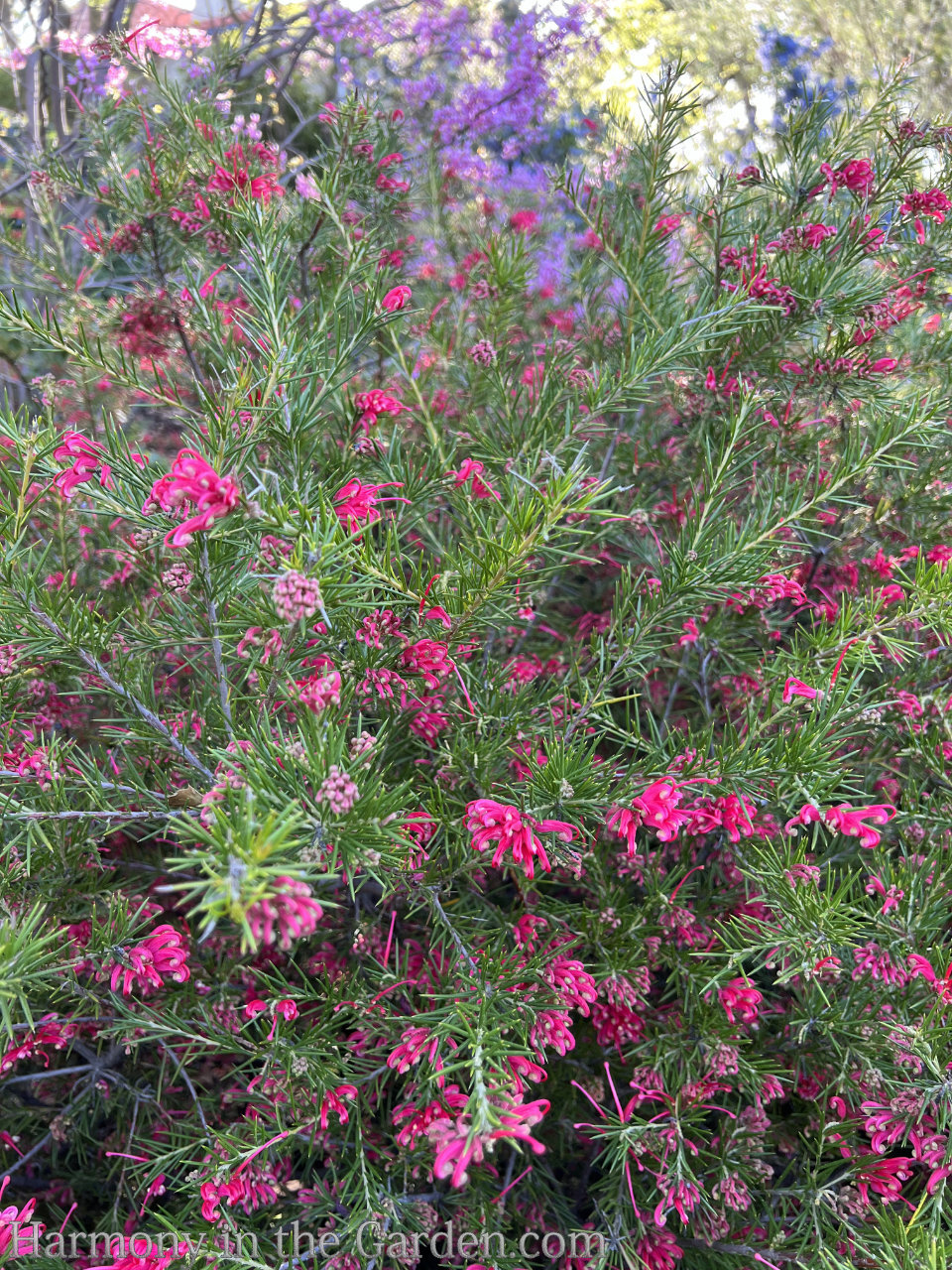
After experimenting with greening up yellow foliage, I wanted to let you know that I’ve had fantastic luck with this Ironite spray.
It’s important to follow directions and apply it when the ground is moist (perfect for early spring after a rainfall) and give it time to work. My grevilleas have taken up to 6-8 weeks to show results.
For the most part, grevilleas respond really well to pruning, so don’t worry about cutting back a wayward branch.
Pruning is also a great way to encourage even more blooms to form at the tips of the new growth, so prune away!
I’ve been designing with grevilleas for the past 20+ years, and am thrilled to see more and more varieties available in nurseries.
So with that, here are my favorite grevilleas that I recommend for your gardens.
Groundcovers and front of the border varieties (3-feet or less)
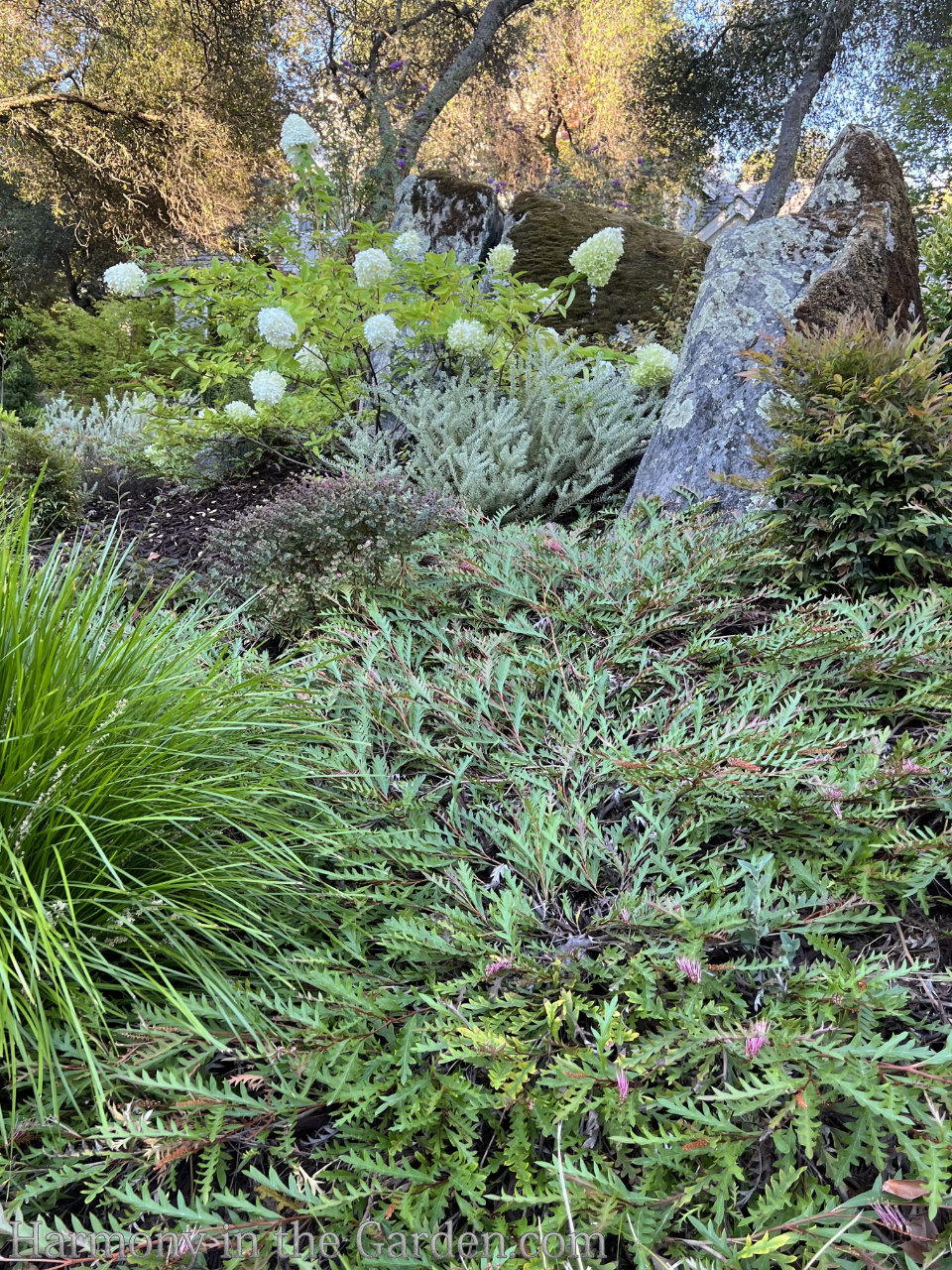
Grevillea ‘Fanfare’
This is the most amazing weed-suppressing, low-water, EVERGREEN groundcover I’ve ever planted. I only wish it was more available, and have only seen it twice in nurseries.
If you’re lucky enough to find ‘Fanfare’ buy it – if not for you, for another gardening friend who needs a ground cover that grows 1’ tall x 10-15 feet. Yes, it spreads wide yet remains low. It has unique ,deeply lobed foliage, but the dark red toothbrush-shaped flowers steal the show.
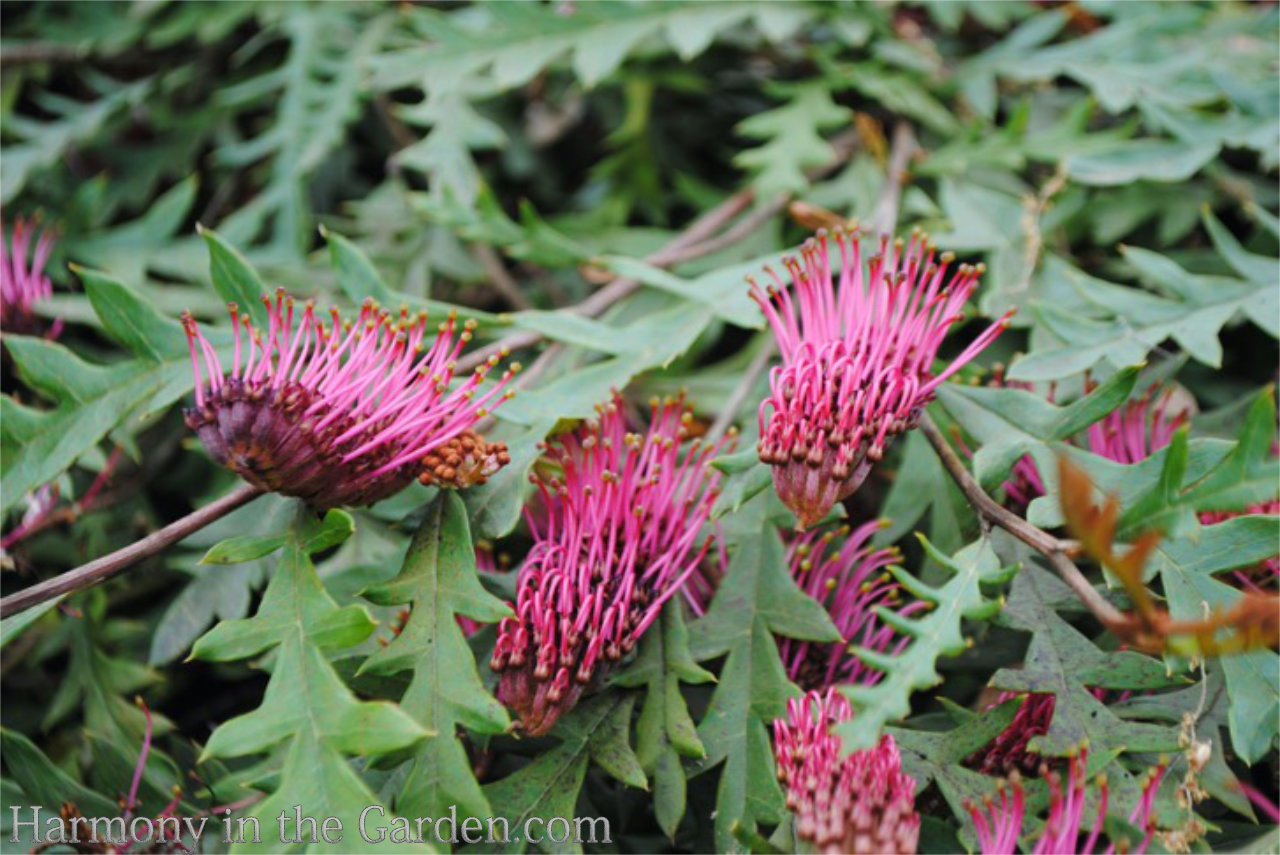

Grevillea ‘Mt. Tamboritha’
This ground cover has an entirely different appearance than the previous grevilleas mentioned.
It has stubby succulent-like foliage, which grows close to the stem, and small coral & pale pink flowers. ‘Mt. Tam’ is hardy down to 25 (possibly even 20, by some accounts) and blooms for MONTHS throughout the year, starting in January. January!
It’s a very showy front-of-the-border, evergreen plant and one of my top 10 favorites ever. I use them often in my designs, placing them along the front of the border where they’ll bloom almost continually with little water.
Growing to 1’ x 4’, they gently drape themselves around other nearby plants, making them indispensable in my garden designs.
People often ask me if they can substitute ‘Coastal Gem’ for ‘Mt. Tam’ since they’re so similar in size. I rarely do this in my own designs, as ‘Coastal Gem’ is a bit more open growing with flowers that aren’t as vibrant as ‘Mt. Tam.’

Grevillea ‘Bonnie Prince Charlie’
I’m in love with the vibrant red-orange and yellow blooms of this variety, adding so much color to my winter garden. Growing to about 2 1/2 tall x 4′ wide, makes ‘Bonnie Prince Charlie’ perfect for the mid-border.
(fun fact: this is named after Prince (now King) Charles, and not after the young ruler from the 1700’s of the same name.)


Grevillea ‘Magic Lantern’
I first spotted this variety at the UC Davis Garden and fell in love with the feathery gray foliage combined with bright red blooms.
This variety grows between 2-3 feet and spreads to 6-10 feet, so make sure to give it plenty of room!
Mid-Sized, ideal for the middle of the border (3 to 6-feet tall)
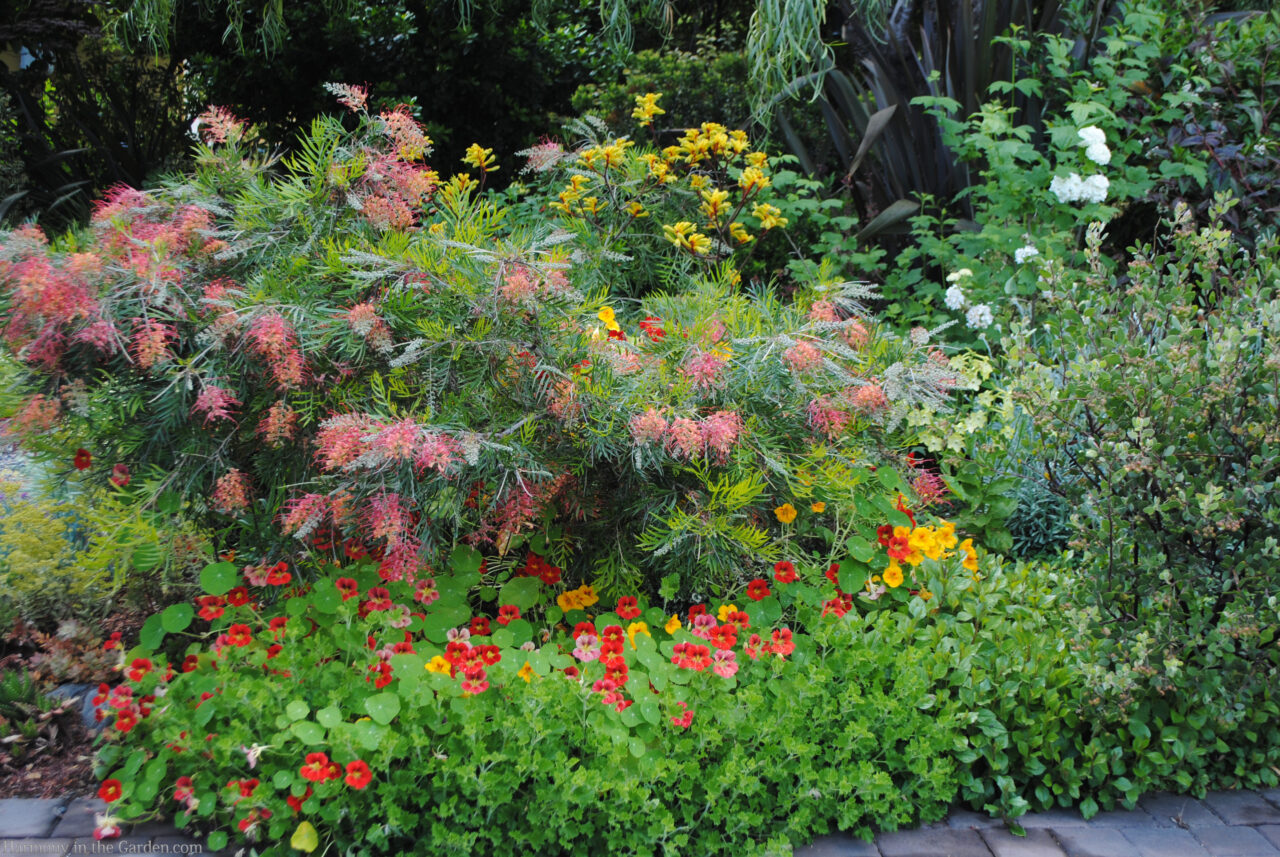
Grevillea ‘Superb’
The aptly named ‘Superb’ has been a showstopper in my garden for years, blooming intermittently throughout the year.
Quickly growing to 4’x4’ (sometimes a bit larger), ‘Superb’ wants full sun, fast drainage, and just a little supplemental water once established.
Given these conditions, you’ll be rewarded with hundreds of large, 6″ flowers of soft coral and orange.

Grevillea ‘Peaches & Cream’
Similar to ‘Superb’ is ‘Peaches and Cream,’ growing to 6’ tall, and a bit wider to 8.’ If you prefer pastels in your garden, this variety is for you, with loads of spectacular apricot and cream blooms.
It’s not just hummingbirds who love these flowers; other birds do as well (like the bushtit, below.) In fact, just today I saw a female oriole devouring the nectar from this same shrub!

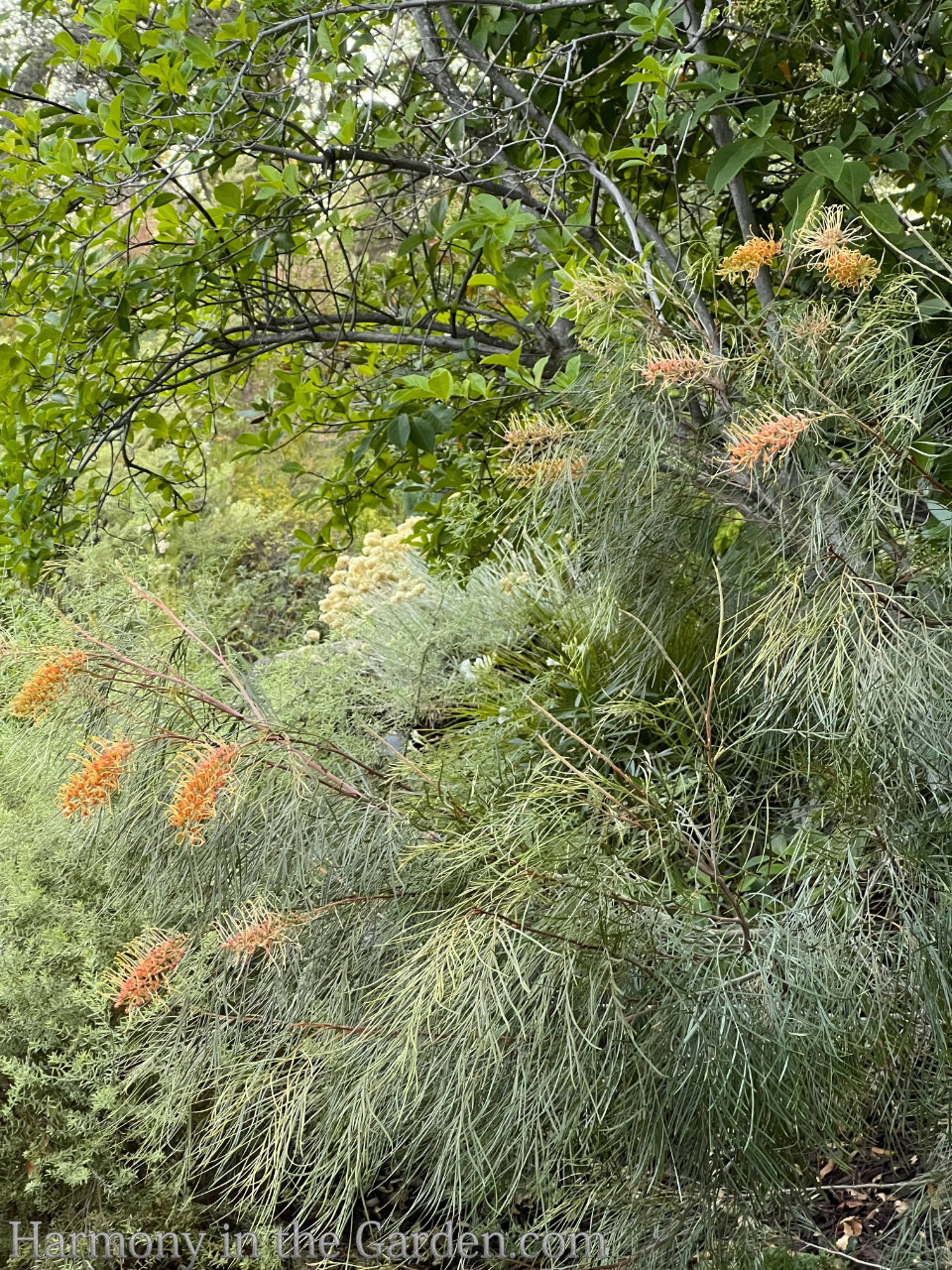
Grevillea ‘Little Honey’
This fast-growing grevillea grows to 8-10’ x 6-12’ wide with gorgeous orange/yellow blooms.
Mine is planted on a slope (great for fast drainage, which they LOVE) and under a tall toyon shrub and magnolia tree. This way, it gets a bit more overhead protection from frosty nights, which is necessary as this variety is a little more frost-tender than others in my garden.
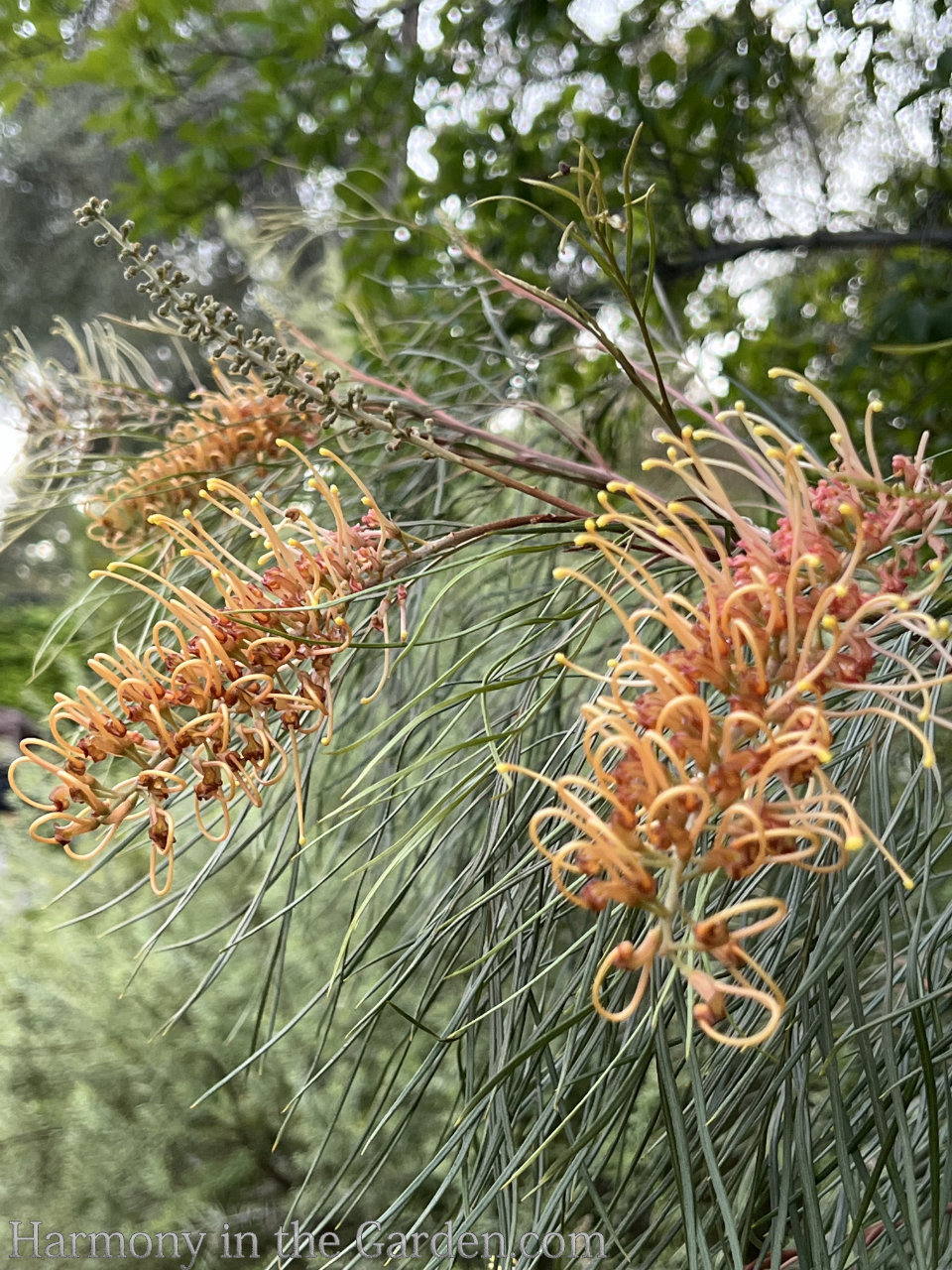
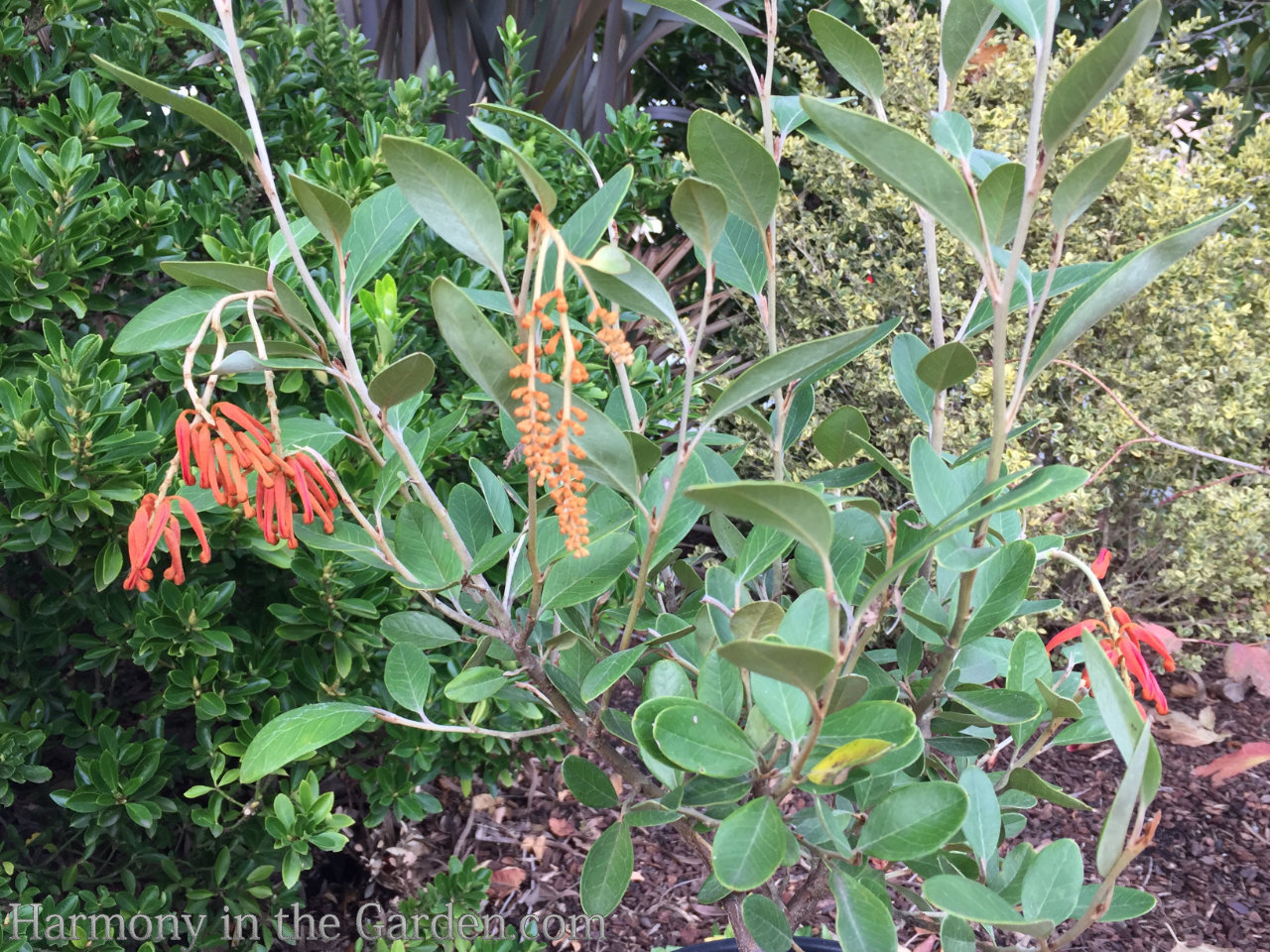
Grevillea victoriae ‘Murray Valley Queen’
Naturally found in the higher elevations in Australia (where they even survive light snowfall), ‘Murray Valley Queen’ is one of the more cold-hardy grevilleas, surviving temps to 5-10 degrees.
As you can see, the rounded, elongated foliage is very different than other varieties resulting in a more ‘traditional shrub’ appearance.
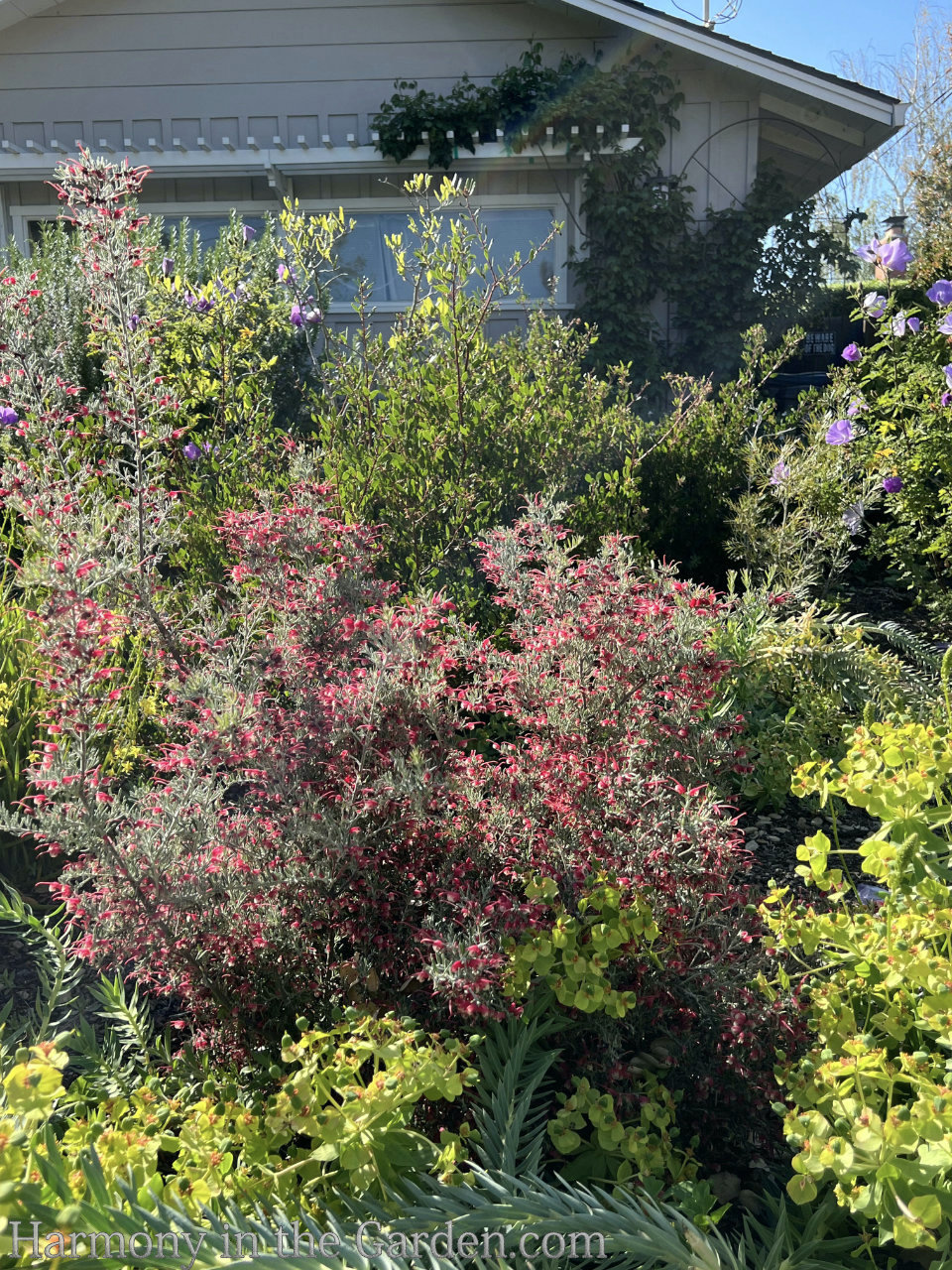
Grevillea lavandulacea ‘Penola’
This variety is happily growing in my client’s garden (click here for a before and after.)
The gray foliage contrasts nicely when surrounded by shades of green, and those bright pink flowers are absolutely darling. It grows to 4-5’ tall by 8’ wide, so make sure to give it plenty of room to stretch out!
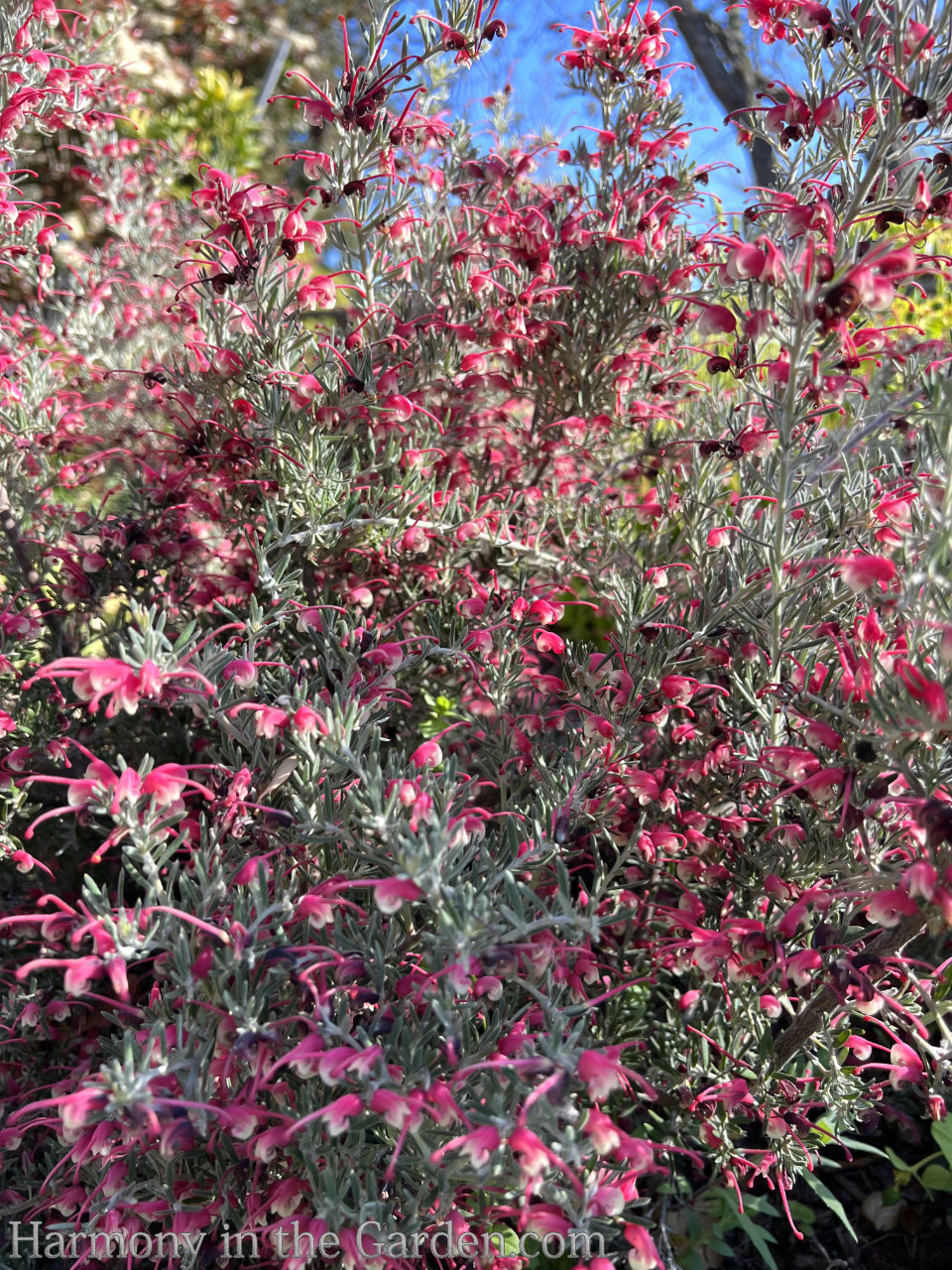
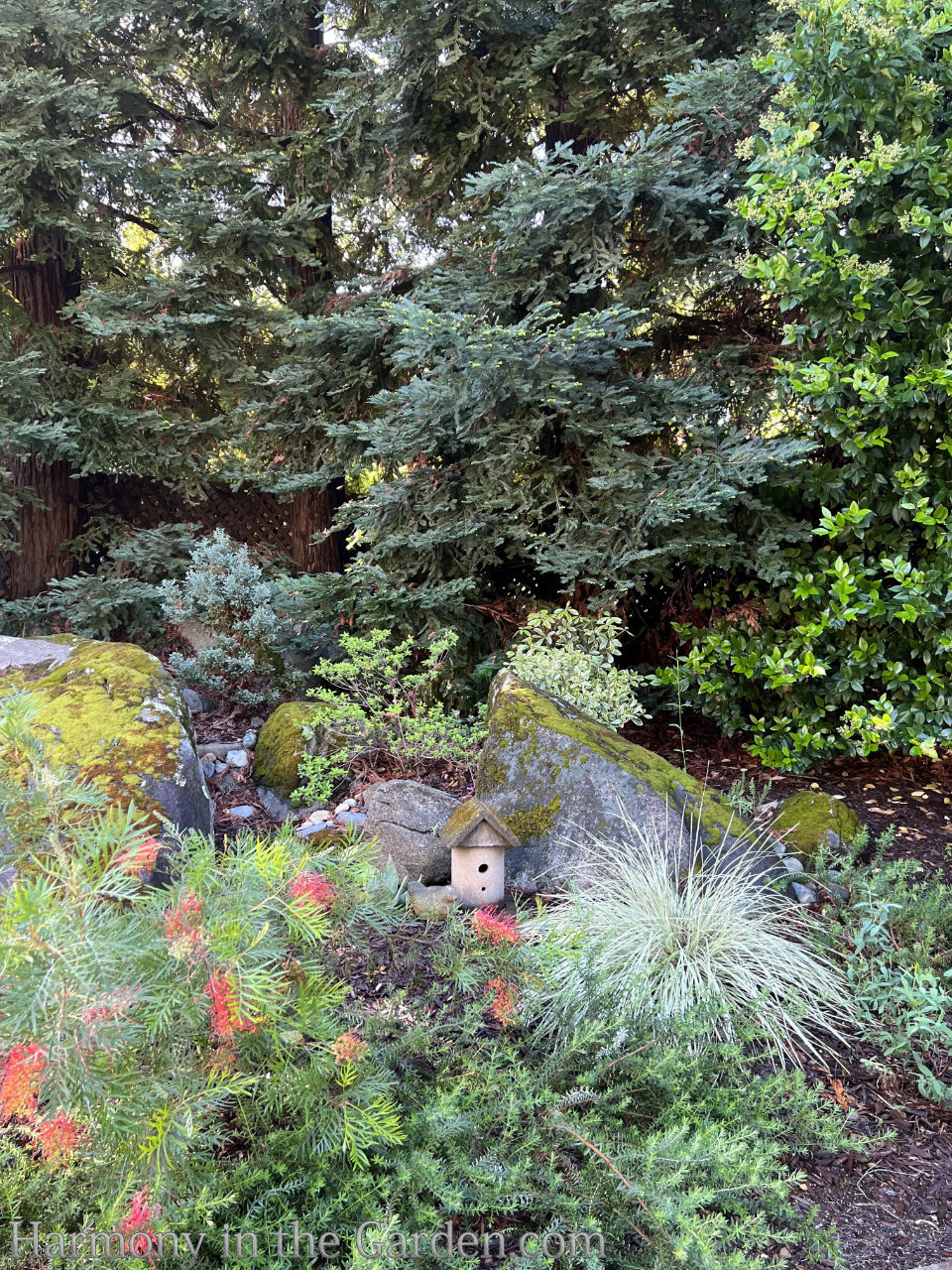
Grevillea ‘Ned Kelly’
Named after an Australian outlaw in the 1800’s, ‘Ned Kelly’ is a cross between ‘Robyn Gordon’ and’ Superb’.
This variety grows faster than ‘Superb’ and is a bit taller and more upright. As you can see, below, the flowers are more vibrant with deep, rich shades of coral, yellow and orange.
It also seems to be more frost tolerant than its parents, surviving winter nights that dip into the 20s.

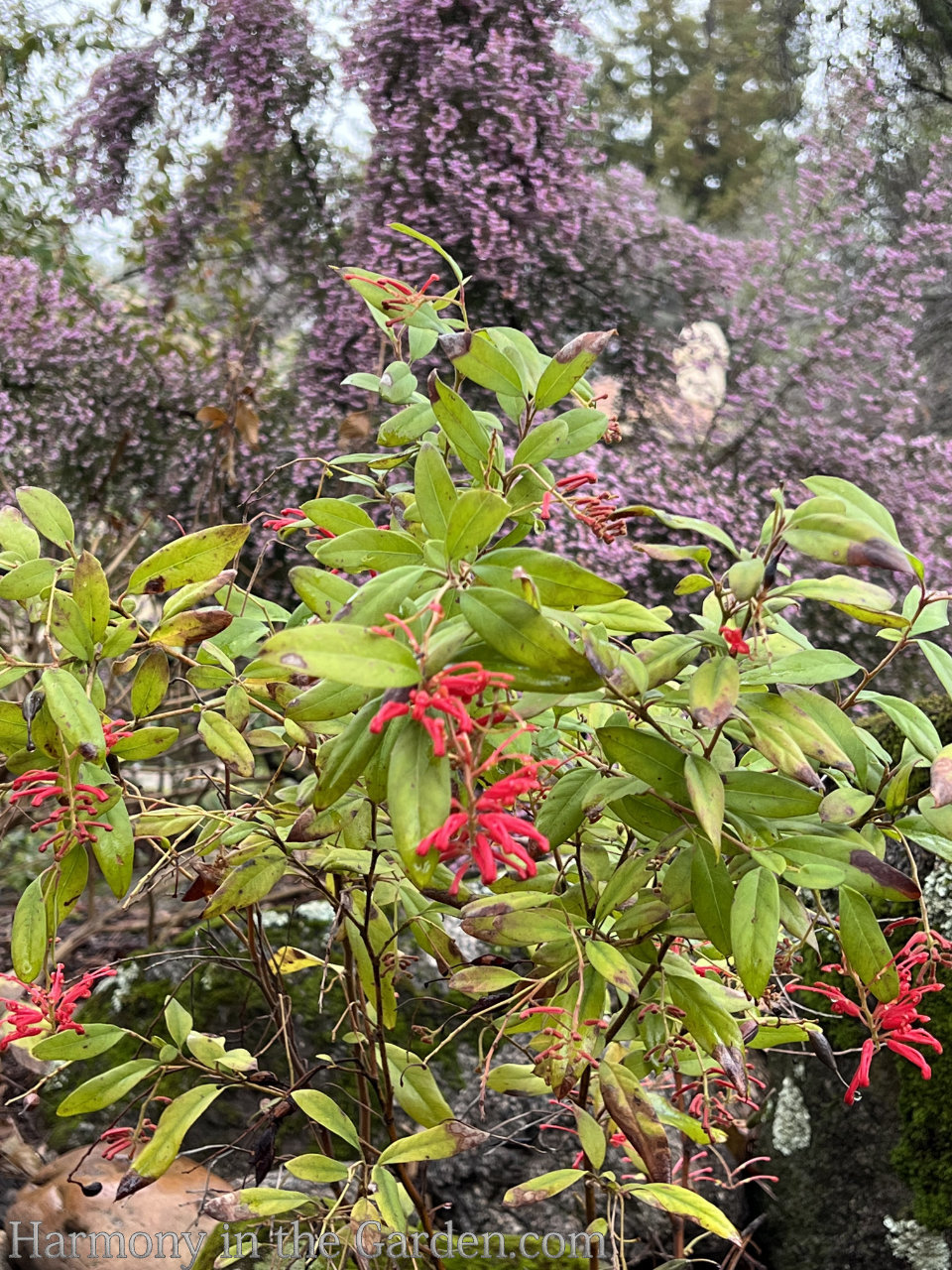
Grevillea ‘Deua Flame’
‘Deua Flame’ is an endangered variety and is reported to be a super easy grevillea to grow.
However, in my experience both in the Bay Area and now here in Granite Bay, it’s been challenging to get it to grow.
My 3rd attempt, however, has paid off ,and my 3-year-old plant is now starting to flower with very little attention from me.
This variety seems happiest planted under the canopy of tall and wispy live oak trees versus planted in the blazing hot sun.
Grevillea ‘Scarlet Sprite’
Growing to 4’x6’, ‘Scarlet Sprite’ has prickly needle-shaped foliage with profuse, red flowers.
It’s so sharp, I’ll often use it as a ‘barrier plant’ to keep deer away from other, more munchable plants – works like a charm!
Towering Varieties – great for impact and screening (6’-15’ tall)

Grevillea ‘Long John’
‘Long John’ is one of my very favorite varieties of all time. It quickly grows to 10-15’ x 8-12’, but I’ll warn you – I’ve seen them grow upwards of 18’ when happy.
Its unique foliage resembles very long, thin pine needles, creating a wispy see-through effect in the garden.
However, despite its imposing size, this plant’s light and airy nature helps prevent it from appearing too bulky in the garden. The flowers are a dark rose-pink color that attracts hummingbirds as well as tons of beneficial insects and bees.
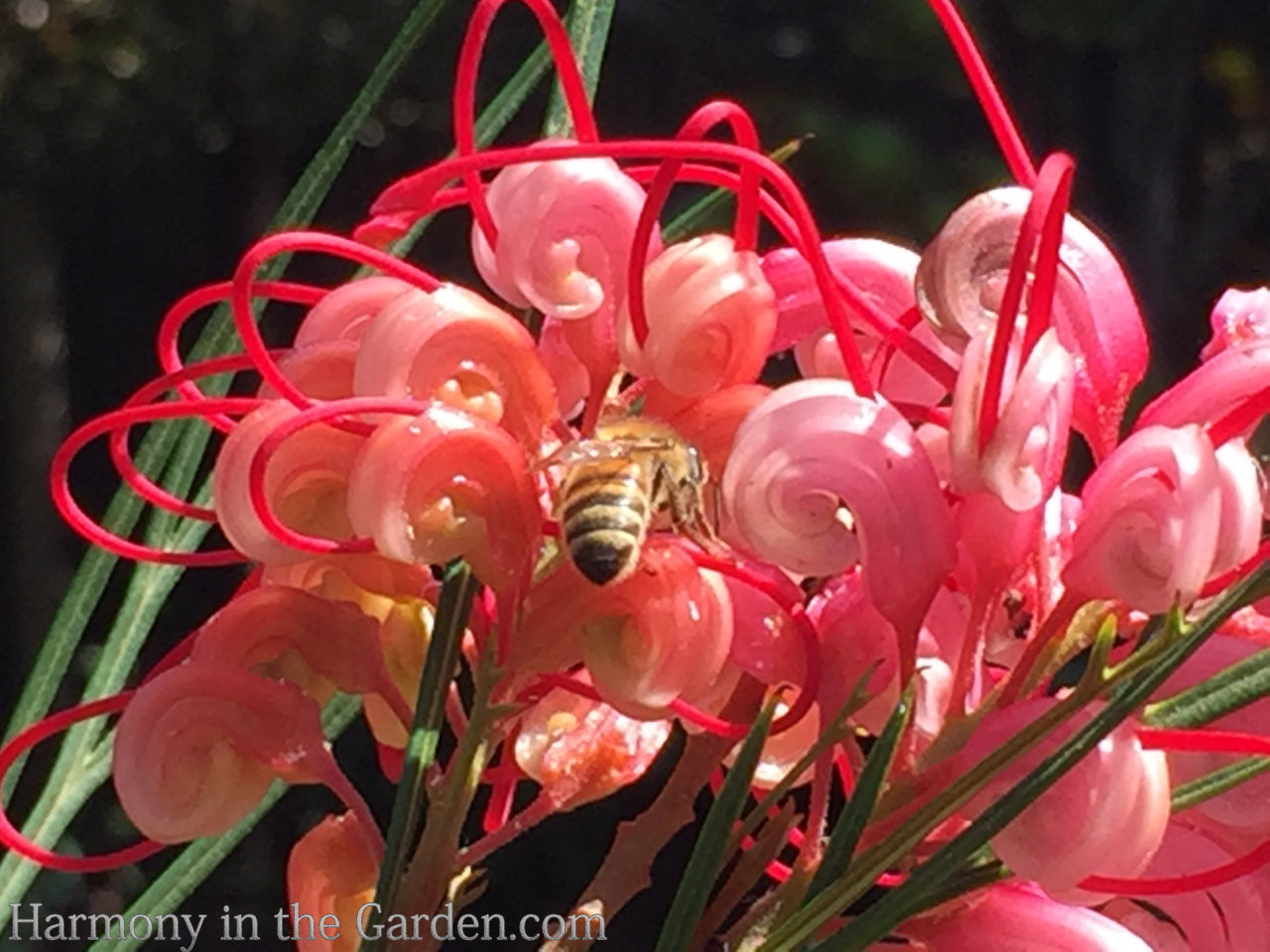

***Grevillea ‘Bonfire’
As you can see from this photo, a towering ‘Long John’ is on the very top of the hill, with the mid-sized ‘Bonfire’ in the front.
While I loved this combination, I can no longer recommend this plant as, unlike any of the other varieties I’ve grown, ‘Bonfire’ hangs on to its dead foliage for dear life.
In fact, it’s next to impossible for me to pull it off, resulting in a half-dead-looking plant for most of the year. Which is such a bummer, as those fire-engine-red blooms were so pretty!
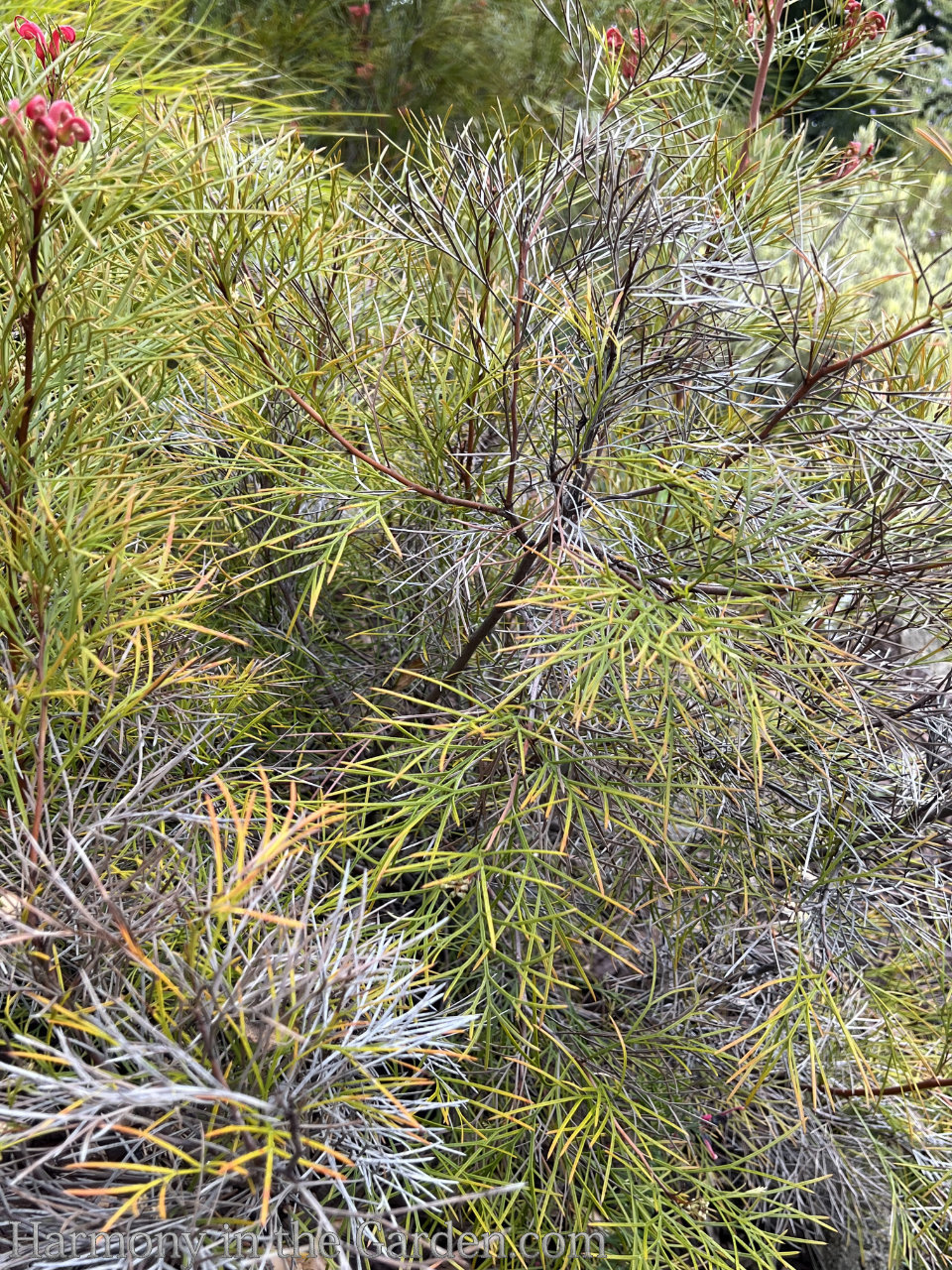
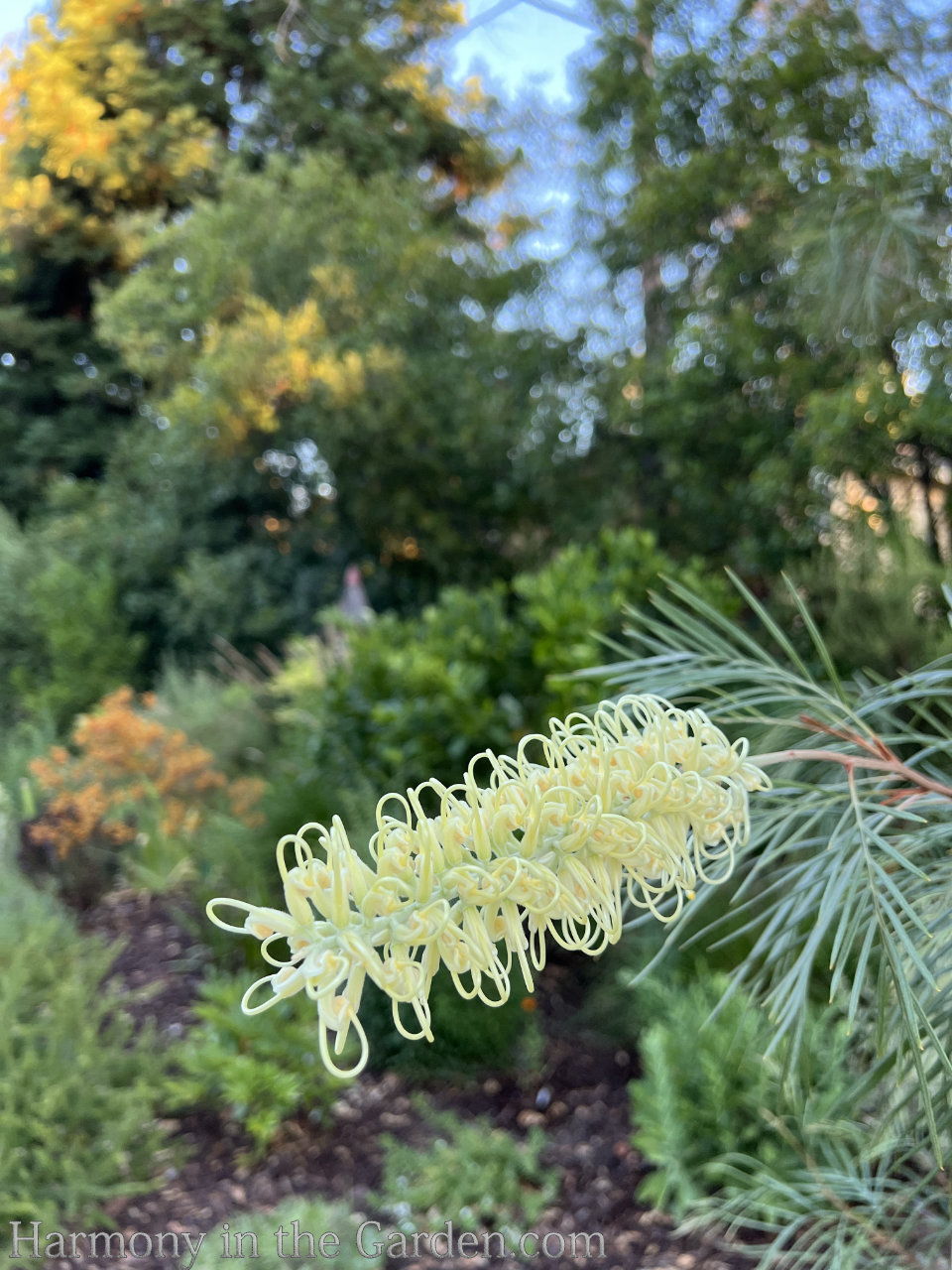
Grevillea ‘Moonlight’
‘Moonlight’ is another of my favorite tall varieties, growing to a towering 15’ tall.
It’s 6” long creamy white flowers are literally dripping with nectar, whipping the bees into a frenzy.
I’ve read that hummingbirds tend to ignore this variety as they’re not as attracted to white flowers. Interesting, as I’ve definitely noticed this to be true in my own garden!
Actually, I think the bees appreciate not having the hummers dive bomb this grevillea, having the oversized flowers all to themselves!
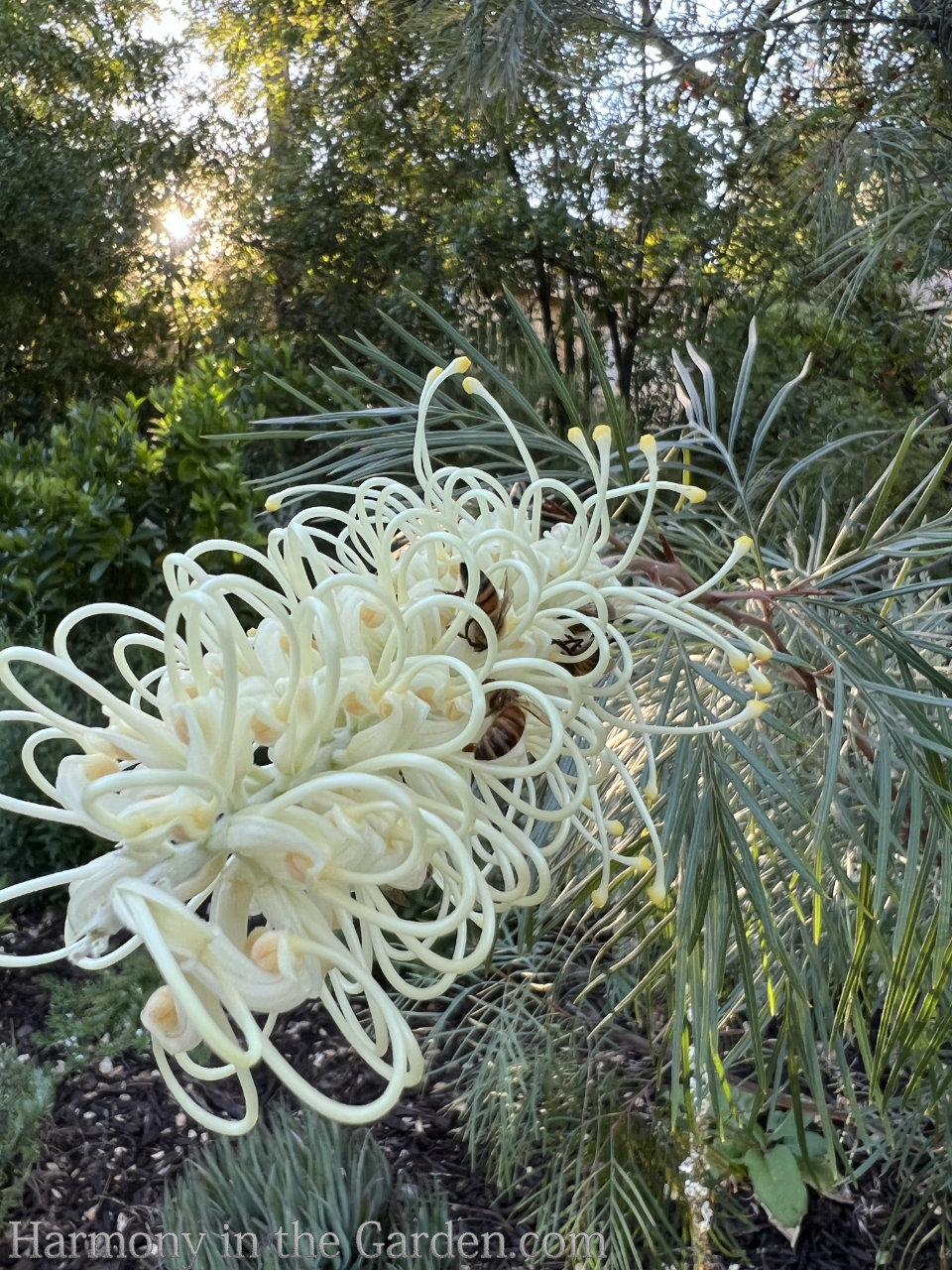
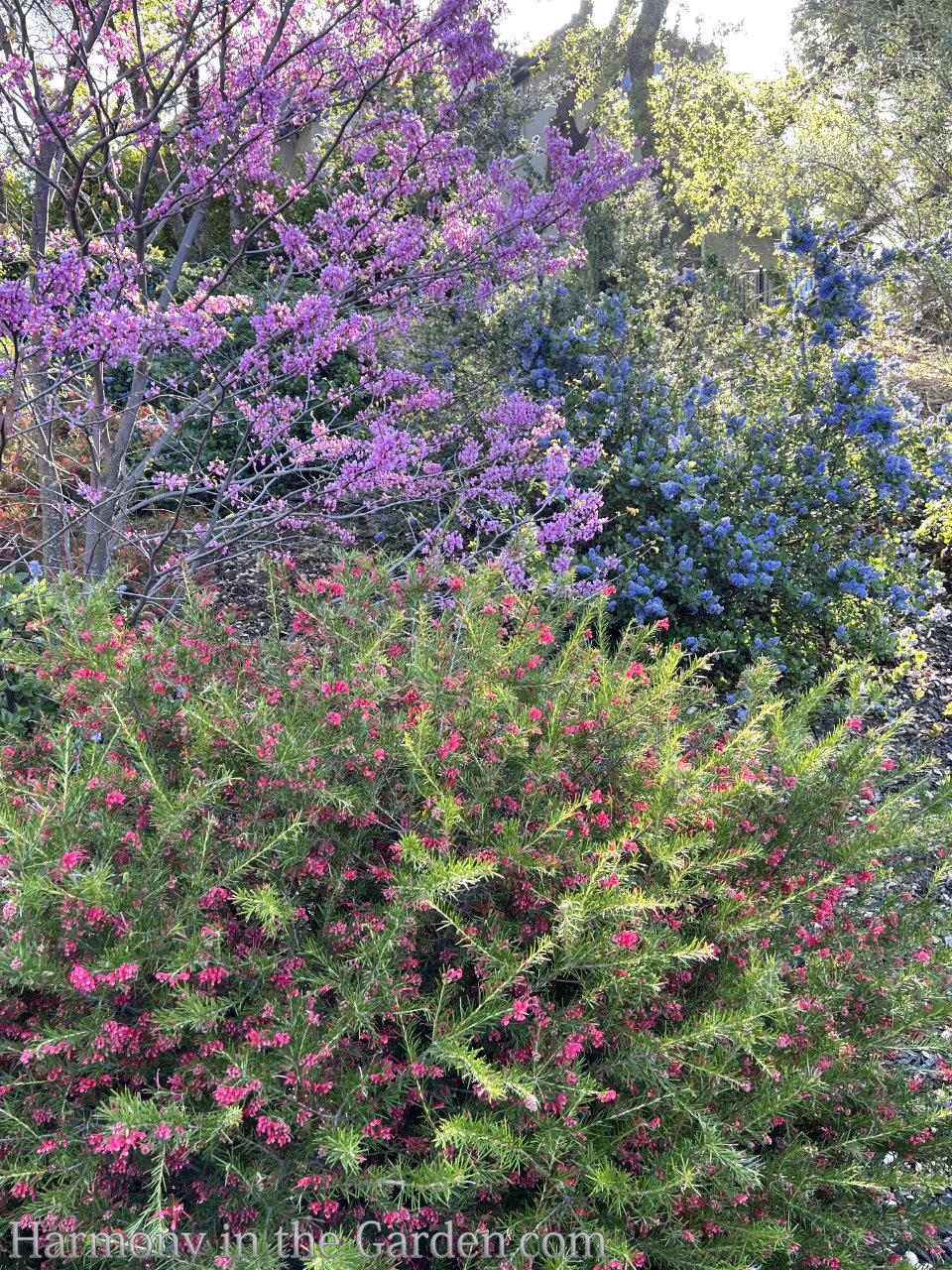
Grevillea ‘Canberra Gem’
This tough and fast-growing variety’s dark green, needle-like foliage adds a welcome ‘lush’ quality to hot and dry gardens.
And, when covered with dark rosy-red blooms, it appears even more lush! It definitely doesn’t look like most drought-tolerant plants.
This is one of my favorite combinations that I pass by on my morning walks. Just look at this fantastic spring-blooming combination of the blue-flowered ceanothus, the magenta Redbud tree, and the red grevillea blooms.
The needle-like foliage is a bit prickly, so you’ll want to wear gloves when pruning.
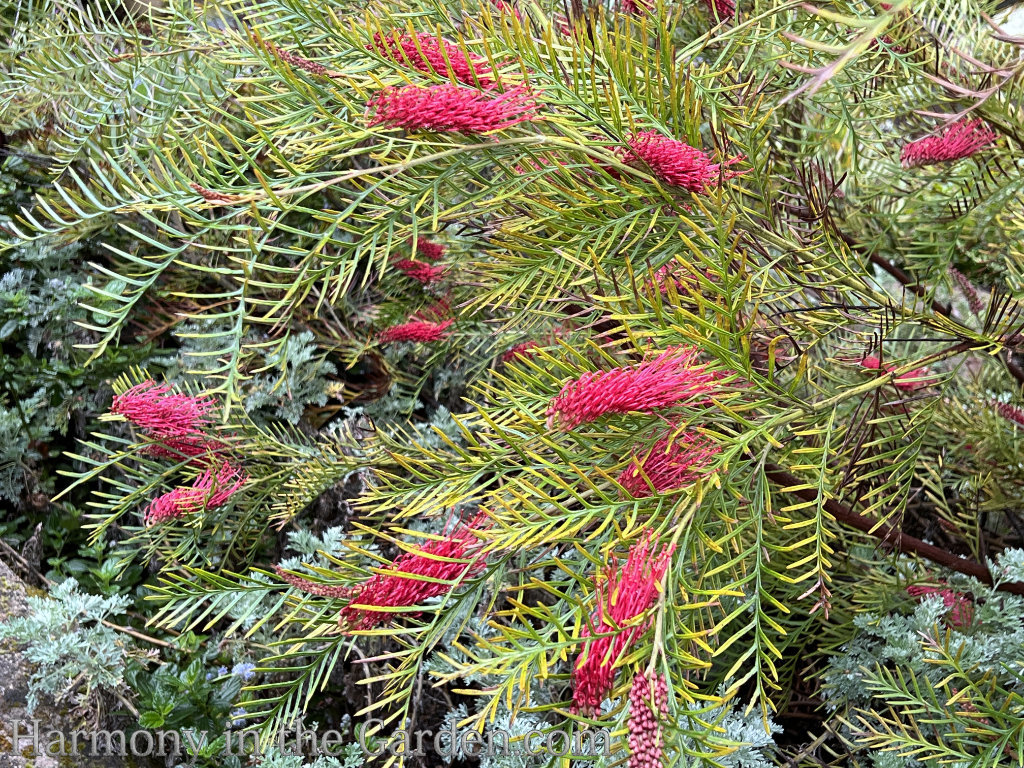
Grevillea ‘Red Hooks’
Similar to the groundcover ‘Fanfare’ above, the vibrant red, 6-inch long, toothbrush-like flowers absolutely cover this towering beauty in early spring.
This variety grows super fast, so make sure to stake it upon planting so it doesn’t blow over in a strong wind (speaking from experience!)
It’s foliage does tend to have gold undertones, no matter how much I apply iron (both foliar spray and soil drench) but that’s okay – those flowers more than make up for the slightly chlorotic appearance.
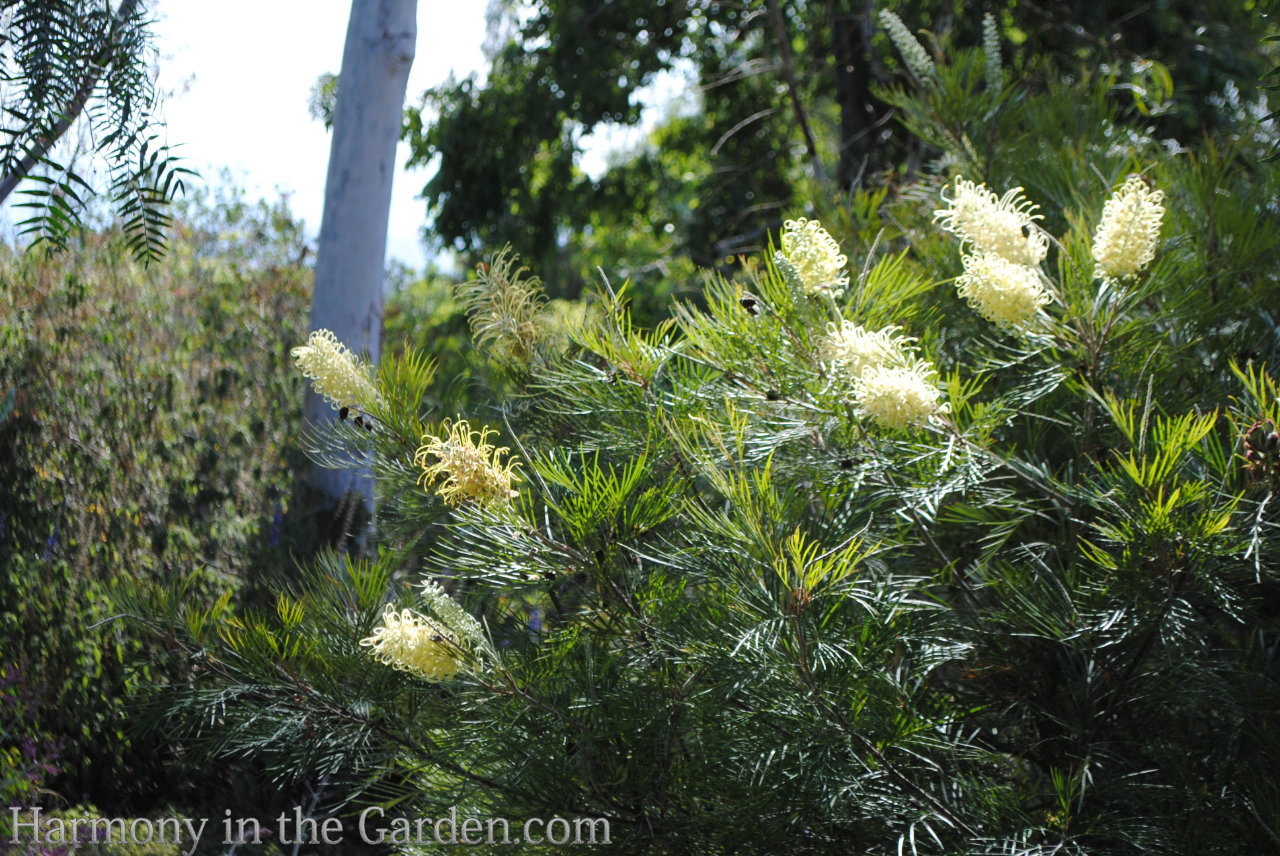
As promised, here are a few more articles that you may find interesting:
For more information about adding iron to your grevilleas, take a look here at one of the best sites ever from Monterey Bay Nursery.
And, for more in-depth information on cold-hardy grevillea varieties, here’s a fantastic article from The Desert Northwest, and this one by Pacific Horticulture.
So what are some of your favorites? I’m always looking for new varieties – please share!






30 Comments
What inspiring photos and descriptions. I’m a hobby gardener in southern Oregon. Our climate is Mediterranean – hot in August like Sacramento. I’m starting from scratch: removing sod, laying out path boundaries. It’s an exciting time, but also lots of back work. I’m splurging on a drill bit auger to make planting a lil easier down the road!
So glad you enjoyed the post. As a kid, my husband lived in Hermiston and tells me it’s unbelievably hot and dry – not what most people think when they hear Oregon. Sounds like it’s similar to where you live, too. Good for you on purchasing an auger! We need to help our poor bodies as much as we can – who needs a gym when you’re a gardener, right?
What a beautiful article on my favorite, but rare tree! Would you believe that we sold our home in SoCal in October, with a gorgeous 10-foot tall Grevillea out front. Only to drive by our former home a couple months later only to discover it GONE!!! I cried in shock and still am hurt up until today. My husband had to remind me that it was no longer “our house”. Now I ask the question, do Grevillea transplant well when moved?
Hi Andrea, I’m so glad you enjoyed my article but so sorry to hear about the demise of your grevillea. It’s heartbreaking, isn’t it? When I moved from my previous home I had a gorgeous garden and within a few years it was completely overgrown with half the plants dead. It’s a tough pill to swallow, but your husband’s right (mine says the same thing to me!) Regarding transplanting grevilleas, I’ve had mixed results as they seem a bit temperamental. It seems the harder I try to baby them, the faster they die and the transplants that survived are the ones I never really cared about in the first place (isn’t that always the case? ha!) The largest size I’d try and transplant is a 5-gallon (which surprisingly is the one that did really well), and larger ones seem to resent it the most (as is usually the case with most plants.)
Hi. Rebecca
I loved this post/blog! I live in Raleigh, NC and have 4 Grevillea ‘Poorinda Leane’. I love them. My oldest is 5 years old and has sailed through 6 weeks of no rain and was untouched by 9 degrees F. I tried two other varieties before I knew very lean soils, planted them in beautiful rich composted soil, they died within weeks. Now that I know a lot more about their growing conditions I would like to try other varieties again. Do you know of any mail order nurseries? I found some great places but they don’t ship!
I was intrigued with the theory of leaf size and shape corresponding to winter cold and % humidity in the article from ‘The Desert Northwest’ that you linked to.
Again, I truly enjoyed your article!
Cindy Chappell
Hi Cindy, I’m so glad you enjoyed this post AND that you’re having luck with fabulous grevilleas! It’s amazing how tough they are and it’s so easy to ‘love them to death’, but once you know what their requirements are, they’re fairly easy. I did a quick search and you’re right, so many sources don’t deliver. However, I did find a few at here https://farreachesfarm.com/search?q=grevillea&options%5Bprefix%5D=last, here https://hhplantnursery.com/ and at Digging Dog Nursery. You’re so lucky to have that beauty ‘Poorinda Leane’! I’ve never tried it and will definitely add it to my ever-growing plant list. 🙂
Hi Cindy,
Small world—I’m also growing them in Greensboro, NC (to the west, higher, and colder). These plants are extremely hard to find via mail order, it seems. Here are some existing nurseries that have been sources, either now or in the past.
Australian Plants (CA)
Cistus (OR)
Desert Northwest (Ian Barclay reported 8 F in Sequim, WA last winter, so mail order remains on hold)
Digging Dog (CA)
eBay (sporadic)
Etsy (sporadic)
Far Reaches Farm (WA)
Forest Farm (OR)
Gossler Farms (OR)
One Green World (OR)
Plant Delights (NC, but has not stocked them in years)
Woodlanders (SC)
Most of these sources typically only have one or two varieties available at a time. Australian Plants and Desert Northwest have had the widest selections, but you may want to read Ian’s blogs and literature from Neil Bell of OSU (now retired) for additional hardiness information before jumping in with both feet. Poorinda Leanne, Neil Bell, The Precious, and Molonglo are perhaps the hardiest varieties here, though I’ve had success with several others. Good luck!
Trent Stevens
Trent, thank you so much for the detailed and oh-so-informative response to Cindy. I’m sure she (and others) will be so grateful to know about all the online sources for grevilleas. I sure wish they were easier to come by, but I’ve usually only seen the ground covers available in 1-gallons at the nursery with the rest in 5-gals, which is probably why nurseries don’t really want to ship such large plants. That’s my assumption, at least.
Hi Rebecca,
You’re more than welcome! The five-gallon limitation may indeed be true for most of the Bay Area and SoCal nurseries. Another reason for the reluctance of nurseries to sell grevilleas via mail order may be the elevated risk of plant death in other areas of the country. Most of Australia is equivalent to USDA Zone 9a or higher and most of the US is not, plus many US gardens/soils have high levels of phosphorus. There are ultimately very few varieties out of hundreds of grevillea species and hybrids that will survive in Zone 8b and lower.
For example, Plant Delights (in Zone 7b/8a NC) announced to much fanfare that it was offering Canberra Gem and Murray Valley Queen, then stopped selling grevilleas altogether for unexplained reasons. As Loree Bohl has stated on her Danger Garden blog, grevilleas love to die (it’s their favorite thing to do), and dead plants do not lead to high levels of customer satisfaction. That said, the right grevilleas in the right soils/climates are definitely interesting additions to any xeric gardens that can support them. Thanks for highlighting them in your blog!
Trent Stevens
That’s exactly what I was thinking. If I were a nursery it’d be too much of a risk cost-wise to deal with so many potential barriers to success for grevilleas. I love what Loree said and she’s 100% right – so funny (yet so sad!) The grevillea that’s been absolutely bullet-proof in my gardens throughout the Bay Area, and especially here in my super hot Granite Bay garden (it’s 101 this weekend) are the g. ‘Mt. Tamboritha’s. The only thing that’ll kill them is too much water or too much shade. And even the shade doesn’t kill them, just makes them really rangy. So glad you enojoyed my post and believe it or not, I’m actually in the middle of writing an article on grevilleas for The American Gardener – your information has been super helpful and very timely, thank you!!! It’s so nice to hear what does well in your climate.
Also, Dancing Oaks (OR) also has a few, including the hardiest of them all, Grevillea australis.
I’m replying to this here because I can’t reply to the earlier post . . . you’re welcome about the information. However, I do have some good news and some bad.news: The Desert Northwest Nursery in Sequim, WA is now accepting new mail orders, but Ian won’t have any grevilleas available for shipment until 2025. So, for those of us who don’t live on the West Coast, grevillea availability may continue to be patchy for a while . . . too bad, because the triple-digit heat doesn’t even seem to phase them!
Thanks again for the info, Trent! In my Granite Bay garden, the temps this week are consistently triple digits – absolutely brutal. But the grevilleas? They couldn’t be happier. I have a feeling with summers getting hotter and hotter we all might be seeing lots more varieties available in nurseries (at least that’s my hope!)
Hi Rebecca,
So grateful to have stumbled across your Grevillea blog! It inspired me to install ‘Mt. Tamboritha’ for a (now very happy) client who wanted something showy and long-flowering to spill over her brick patio wall. I now find myself recommending Grevilleas to clients on a regular basis and sending them the link to your extremely handy guide.
Thank you!
Paul
Hi Paul, and your comment makes me so happy! Aren’t Mt. Tam’s wonderful? I can’t sing their praises loud enough. In January I noticed mine were covered with hungry black-tailed bees and was so surprised to see them out so early in the year. After googling them, I read they’re some of the very first to emerge and are desperately looking for blooming flowers (Mt Tam to the rescue!) Another one that I’ve fallen in love with is the ‘Bonnie Prince Charles’ (I updated my grevillea post just two days ago to include this, as well as how to green up yellow leaves.) I’ve seen this newer variety in your area so you might have luck finding it at your nurseries. Thanks again!
Hi again, Rebecca!
I’m wondering if you can recommend a showy grevillea that will fare well in a large container.
Thank you,
Paul
Hi Paul – you know, I haven’t planted grevilleas in containers before so I’m not entirely sure how they’d fare in pots. From the ones I’ve tried, I think the ‘Duea Flame’ ‘Bonnie Prince Charlie’ or Grevillea victoriae ‘Murray Valley Queen’ might be candidates since they tend to be a little more delicate by nature versus the big ones, with oversized foliage (like the ‘Peaches & Cream’ or ‘Superb’) and they don’t have prickly leaves (like the ‘Scarlet Sprite’) Oh, one more that would be good for a container is the g. lavandulacea ‘Penola’. If you decide to give it a try I’d love to know if you have success! Good luck!
Hi Rebecca,
I wanted to follow up on my ‘grevilleas in containers’ note. I planted ‘Deua Flame’ in a container several months ago and it’s doing fabulously! For the same client, I planted ‘Bonnie Prince Charlie’ to spill over a low wall and it, too, is performing beautifully! For a different client, I’m also having success with ‘Mt. Tamboritha’ in a pot. Triple YAY!!!
Thank you for the inspiration.
Paul
You’re welcome and thanks so much for the update, Paul, and I’m so glad you’re having fantastic luck with them (especially the ‘Deua Flame’ as it can be a bit tricky sometimes) I bet you have some happy clients! 🙂
Hello! My home came with what I think is a Grevillea “Peaches and Cream.” I love it, and I want to take good care of it. It’s putting out flowers, but the leaves are yellow-lime green than the medium green I’ve seen in photos. It has green leaves closer to the trunk. Could it be a type of Grevillea with light-colored leaves? Might that be winter foliage? Or might something be wrong? We’ve had a lot of rain this winter, and the soil has a lot of clay. By the size of the trunk, I’d say it’s been around for a few years. I hope it improves when the dry season starts, but if there is something I could do to help it thrive, I’d like to try. Any advice is appreciated. Thank you!
Hi Tracey, I have a feeling you definitely have a ‘Peaches & Cream’ variety, which is more inclined to have yellow leaves than other varieties (at least in my part of the world.) Your comment prompted me to update my post, which includes information how I green-up my leaves using ironite. While it could be the clay and the rainy winter, I have a feeling you need to apply ironite (use caution so you don’t burn the foliage which I’ve done in the past. But even if you do, it won’t kill the plant, just look unsightly for a season or two) and give it plenty of time (6-8 weeks) to see results. Good luck!!
Thank you! I will give that a try.
Is there a Grevillea that will take some shade. I have 3 peaches and cream and they struggle on the north side of my property. When is the best time to move them to a sunnier location.
Greetings from Cambria
Hi Darlene, I’m sorry to hear about your Peaches & Cream tho it isn’t surprising as grevilleas really do want as much sun as you can give them. In my experience, the larger grevilleas like yours hate to be relocated – I’ve lost so many that way – so I’m not sure if you’ll be able to save them, but its worth a try if the alternative is throwing them away. You might try any time before they start really growing again once the weather warms up, carefully trying to get as much of their rootball as possible without disturbing them too much. The only grevillea that I’ve had luck with in ‘partial’ shade is the groundcover, ‘Mt. Tamboritha’ – all of the other larger varieties tend to sulk in shade. I’ve been experimenting with planting westringeas in the shade and have had great luck with ‘Smokey’ and ‘Morning Light’, if that’s a consolation? They certainly don’t produce those gorgeous flowers, but they have tiny little flowers that the hummingbirds love, and are evergreen with lovely, delicate foliage and are about the same size as the ‘Peaches & Cream’ Good luck and let me know how it goes!
I came across your website while doing a search for plants that appeal to hummingbirds. What wonderful pictures you have along with useful information. The peaches and cream grevillea is stunning. I look forward to reading your past posts. Thanks for including the pertinent links.
Hi Beth, welcome to my blog and thanks for letting me know you’re enjoying it!
I’ve been struggling with what to plant in the full sun part of my garden so the timing of this post is perfect. The area is a berm which was made using rocky, poor soil. The beautiful taller varieties would also provide screening. I hope I will be able to find them in local nurseries. I love your informative posts.
Berms are perfect, Mona, as they’re fast draining (which are a must for grevilleas) and full sun, too? You’ve got the ideal situation – good luck sourcing them. Nurseries are getting better and better about carrying different varieties.
I never knew there were so many beautiful flowers on grevillias so I really enjoyed this post. My previous home came a mature Grevillea ‘Noellii’ which was planted on a rocky slope and received no summer water or supplemental plant food. I did not like the old shrub and didn’t care what happened to it, but over the years I came to respect its’ endurance. It grew next to a well traveled deer trail and was not touched by deer, ground squirrels, gophers, voles, or rabbits.
Hi Elizabeth – you’re not the first person to tell me grevilleas weren’t their favorite shrub, but because they’re SO darn tough, they’ve grown to love them. I’m glad you gave that poor, neglected trooper the respect it deserved! 😉 With the difficult growing conditions in my own garden, I’m a huge fan of just about anything that wants to grow here.